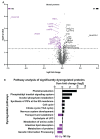Vitamin A Deficiency Alters the Phototransduction Machinery and Distinct Non-Vision-Specific Pathways in the Drosophila Eye Proteome
- PMID: 36008977
- PMCID: PMC9405971
- DOI: 10.3390/biom12081083
Vitamin A Deficiency Alters the Phototransduction Machinery and Distinct Non-Vision-Specific Pathways in the Drosophila Eye Proteome
Abstract
The requirement of vitamin A for the synthesis of the visual chromophore and the light-sensing pigments has been studied in vertebrate and invertebrate model organisms. To identify the molecular mechanisms that orchestrate the ocular response to vitamin A deprivation, we took advantage of the fact that Drosophila melanogaster predominantly requires vitamin A for vision, but not for development or survival. We analyzed the impacts of vitamin A deficiency on the morphology, the lipidome, and the proteome of the Drosophila eye. We found that chronic vitamin A deprivation damaged the light-sensing compartments and caused a dramatic loss of visual pigments, but also decreased the molar abundance of most phototransduction proteins that amplify and transduce the visual signal. Unexpectedly, vitamin A deficiency also decreased the abundances of specific subunits of mitochondrial TCA cycle and respiratory chain components but increased the levels of cuticle- and lens-related proteins. In contrast, we found no apparent effects of vitamin A deficiency on the ocular lipidome. In summary, chronic vitamin A deficiency decreases the levels of most components of the visual signaling pathway, but also affects molecular pathways that are not vision-specific and whose mechanistic connection to vitamin A remains to be elucidated.
Keywords: Drosophila; lipidome; mitochondrion; phototransduction; proteome; retina; retinal; vitamin A.
Conflict of interest statement
The authors declare no conflict of interest. The funders had no role in the design of the study; in the collection, analyses, or interpretation of data; in the writing of the manuscript, or in the decision to publish the results.
Figures







Similar articles
-
Lipidome Unsaturation Affects the Morphology and Proteome of the Drosophila Eye.J Proteome Res. 2024 Apr 5;23(4):1188-1199. doi: 10.1021/acs.jproteome.3c00570. Epub 2024 Mar 14. J Proteome Res. 2024. PMID: 38484338 Free PMC article.
-
Mechanisms of vitamin A metabolism and deficiency in the mammalian and fly visual system.Dev Biol. 2021 Aug;476:68-78. doi: 10.1016/j.ydbio.2021.03.013. Epub 2021 Mar 25. Dev Biol. 2021. PMID: 33774009 Free PMC article. Review.
-
Vitamin A deficiency affects gene expression in the Drosophila melanogaster head.G3 (Bethesda). 2021 Oct 19;11(11):jkab297. doi: 10.1093/g3journal/jkab297. G3 (Bethesda). 2021. PMID: 34849795 Free PMC article.
-
Proteome-wide quantitative analysis of redox cysteine availability in the Drosophila melanogaster eye reveals oxidation of phototransduction machinery during blue light exposure and age.Redox Biol. 2023 Jul;63:102723. doi: 10.1016/j.redox.2023.102723. Epub 2023 Apr 27. Redox Biol. 2023. PMID: 37146512 Free PMC article.
-
[Physiology of the visual retinal signal: From phototransduction to the visual cycle].J Fr Ophtalmol. 2017 Mar;40(3):239-250. doi: 10.1016/j.jfo.2016.12.006. Epub 2017 Mar 17. J Fr Ophtalmol. 2017. PMID: 28318721 Review. French.
Cited by
-
Eye proteome of Drosophila melanogaster.Proteomics. 2024 May;24(10):e2300330. doi: 10.1002/pmic.202300330. Epub 2023 Nov 14. Proteomics. 2024. PMID: 37963819 Free PMC article.
-
Toxicity Evaluation and Transcriptome Analysis of Yellowstripe Goby (Mugilogobius chulae) in Response to 2,7-Dibromocarbazole Exposure during Early Development.Toxics. 2024 Aug 20;12(8):609. doi: 10.3390/toxics12080609. Toxics. 2024. PMID: 39195711 Free PMC article.
-
Absolute Quantification of Photoreceptor Outer Segment Proteins.J Proteome Res. 2023 Aug 4;22(8):2703-2713. doi: 10.1021/acs.jproteome.3c00267. Epub 2023 Jul 26. J Proteome Res. 2023. PMID: 37493966 Free PMC article.
-
Lipidome Unsaturation Affects the Morphology and Proteome of the Drosophila Eye.J Proteome Res. 2024 Apr 5;23(4):1188-1199. doi: 10.1021/acs.jproteome.3c00570. Epub 2024 Mar 14. J Proteome Res. 2024. PMID: 38484338 Free PMC article.
References
Publication types
MeSH terms
Substances
Grants and funding
LinkOut - more resources
Full Text Sources
Molecular Biology Databases

